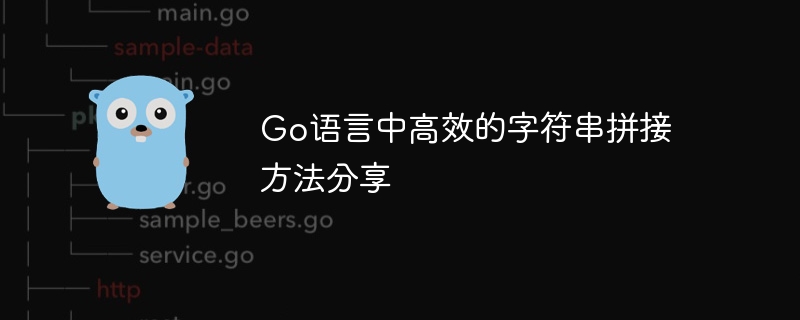

Go language is an open source programming language developed by Google and is characterized by high performance and simplicity. In Go language, string concatenation is a common operation. This article will share some efficient string splicing methods to help Go language developers improve the performance and efficiency of their code.
numbers for string splicing The easiest way is to use numbers for string splicing. For example:
package main
import "fmt"
func main() {
str1 := "Hello"
str2 := "World"
result := str1 + " " + str2
fmt.Println(result)
}Using numbers for string splicing can achieve simple string concatenation, but it is less efficient when splicing strings on a large scale because each splicing will create a new string. String object.
fmt.Sprintf method fmt.Sprintf method to format multiple strings into one string. For example:
package main
import "fmt"
func main() {
str1 := "Hello"
str2 := "World"
result := fmt.Sprintf("%s %s", str1, str2)
fmt.Println(result)
}fmt.Sprintf method is a simple and flexible string splicing method, suitable for small number of string splicing. But when splicing strings on a large scale, the efficiency is not high.
strings.Join method strings.Join method to receive a string slice and join them with the specified delimiter. For example:
package main
import (
"fmt"
"strings"
)
func main() {
strs := []string{"Hello", "World"}
result := strings.Join(strs, " ")
fmt.Println(result)
}strings.Join method is suitable for scenarios where a large number of strings are spliced, and its performance is better than using and fmt.Sprintf methods .
bytes.Buffer type bytes.Buffer type can improve the performance of large-scale string splicing and avoid frequent creation of strings object. For example:
package main
import (
"fmt"
"bytes"
)
func main() {
var buffer bytes.Buffer
str1 := "Hello"
str2 := "World"
buffer.WriteString(str1)
buffer.WriteString(" ")
buffer.WriteString(str2)
result := buffer.String()
fmt.Println(result)
}Using the bytes.Buffer type can greatly improve the efficiency of string splicing, especially suitable for scenarios that require frequent splicing.
Through the efficient string splicing method introduced in this article, Go language developers can choose the appropriate method to splice strings according to specific scenarios to improve the performance and efficiency of the code. Feel free to read and try to apply these methods to optimize your Go code.
The above is the detailed content of Sharing of efficient string splicing methods in Go language. For more information, please follow other related articles on the PHP Chinese website!




